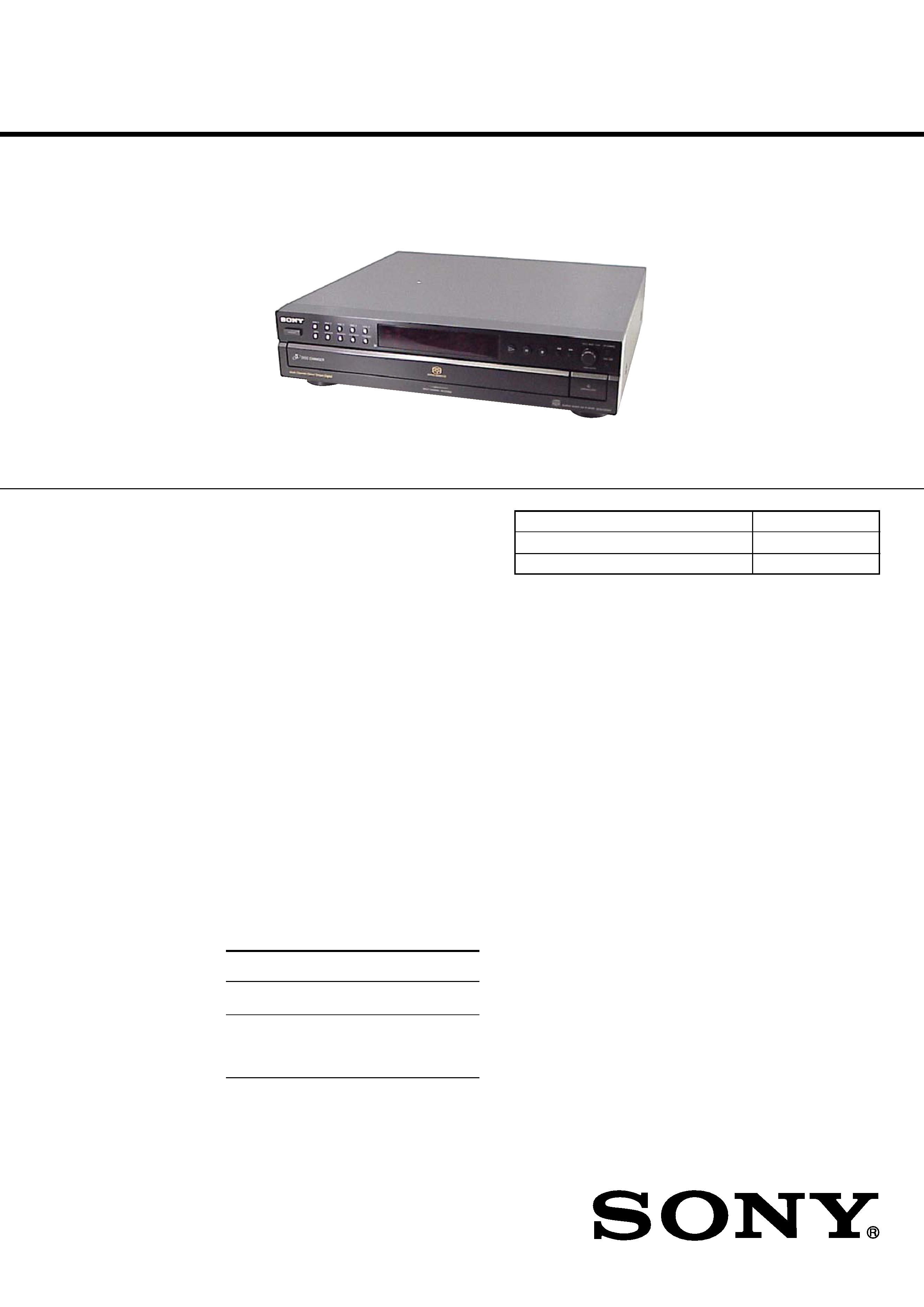
SERVICE MANUAL
Sony Corporation
Audio Group
Published by Sony Engineering Corporation
US Model
Canadian Model
AEP Model
UK Model
SUPER AUDIO CD PLAYER
9-879-006-02
2005E16-1
© 2005.05
Ver. 1.1 2005.05
SPECIFICATIONS
SCD-CE595
General
Laser
Semiconductor laser
(Super Audio CD:
= 650
nm) (CD:
= 780 nm)
Emission duration:
continuous
Power requirements
US, Canadian:
AEP, UK:
When a Super Audio CD is played
Playing frequency range
2 Hz to 100 kHz
Frequency response
2 Hz to 40 kHz (3 dB)
Dynamic range
100 dB or more
Total harmonic distortion rate
0.0035 % or less
Wow and flutter
Value of measurable limit
(
±0.001 % W. PEAK) or
less
When a CD is played
Frequency response
2 Hz to 20 kHz
Dynamic range
96 dB or more
Total harmonic distortion rate
0.0039 % or less
Wow and flutter
Value of measurable limit
(
±0.001 % W. PEAK) or
less
Output connector
*Output only the audio signals of the CD
Jack type
Output
level
Load
impedance
ANALOG
5.1CH OUT
Phono
jacks
2 Vrms (at
50 kilohms)
Over 10
kilohms
DIGITAL
(CD) OUT
OPTICAL*
Square
optical
output
connector
18 dBm
(Light
emitting
wave length:
660 nm)
1
230 V AC, 50/60 Hz
20 V AC, 60 Hz
Power consumption
15 W
Dimensions (w/h/d)
430
110
420 mm incl.
projecting parts
Mass (approx.)
5.5 kg
Supplied accessories
Audio connecting cord
Red and White
2 (1)
Remote commanderRM-SX800 (1)
Battery
R6 (size-AA) (2)
Design and specifications are subject to change
without notice.
××
×
Model Name Using Similar Mechanism
NEW
CD Mechanism Type
CDM79C-DVBU51
Optical Pick-up Name
DBU-3
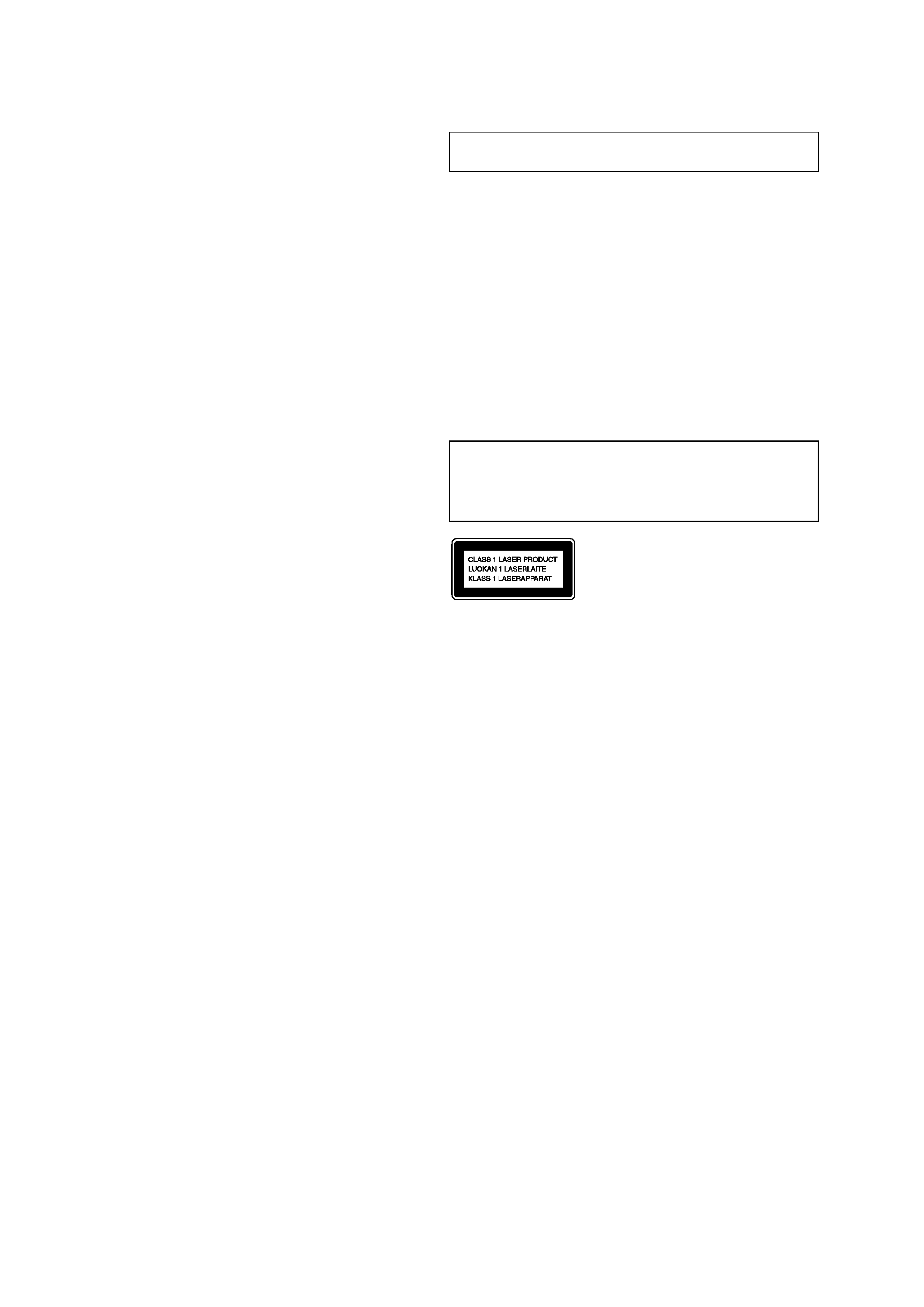
2
SCD-CE595
Notes on chip component replacement
· Never reuse a disconnected chip component.
· Notice that the minus side of a tantalum capacitor may be
damaged by heat.
Flexible Circuit Board Repairing
· Keep the temperature of the soldering iron around 270 °C
during repairing.
· Do not touch the soldering iron on the same conductor of the
circuit board (within 3 times).
· Be careful not to apply force on the conductor when soldering
or unsoldering.
CAUTION
Use of controls or adjustments or performance of procedures
other than those specified herein may result in hazardous radiation
exposure.
This appliance is
classified as a CLASS 1
LASER product. This
label is located on the
rear exterior.
The laser diode in the optical pick-up block may suffer electrostatic
break-down because of the potential difference generated by the
charged electrostatic load, etc. on clothing and the human body.
During repair, pay attention to electrostatic break-down and also
use the procedure in the printed matter which is included in the
repair parts.
The flexible board is easily damaged and should be handled with
care.
NOTES ON LASER DIODE EMISSION CHECK
The laser beam on this model is concentrated so as to be focused on
the disc reflective surface by the objective lens in the optical pick-
up block. Therefore, when checking the laser diode emission,
observe from more than 30 cm away from the objective lens.
NOTES ON HANDLING THE OPTICAL PICK-UP
BLOCK OR BASE UNIT
LASER DIODE AND FOCUS SEARCH OPERATION
CHECK
Carry out the "S curve check" in "CD section adjustment" and check
that the S curve waveform is output three times.
TABLE OF CONTENTS
1.
SERVICING NOTES ........................................... 3
2.
GENERAL ............................................................ 4
3.
TEST MODE ......................................................... 6
4.
DIAGRAMS
4-1.
Block Diagram ................................................................
8
4-2.
Printed Wiring Board -- RF Section -- .........................
9
4-3.
Schematic Diagram -- RF Section -- ........................... 10
4-4.
Printed Wiring Board -- MAIN Section -- ................... 11
4-5.
Schematic Diagram -- MAIN Section (1/4) -- ............ 12
4-6.
Schematic Diagram -- MAIN Section (2/4) -- ............ 13
4-7.
Schematic Diagram -- MAIN Section (3/4) -- ............ 14
4-8.
Schematic Diagram -- MAIN Section (4/4) -- ............ 15
4-9.
Printed Wiring Board -- DISPLAY Section -- ............ 16
4-10. Schematic Diagram -- DISPLAY Section -- ................ 17
4-11. Printed Wiring Board -- MD-94 Board Section -- ...... 18
4-12. Schematic Diagram -- MD-94 Board Section -- .......... 19
5.
EXPLODED VIEWS
5-1.
Main Section .................................................................... 22
5-2.
Front Panel Section ......................................................... 23
5-3.
Chassis Section ................................................................ 24
5-4.
CD Mechanism Section (1) (CDM79C-DVBU51) ......... 25
5-5.
CD Mechanism Section (2) (CDM79C-DVBU51) ......... 26
6.
ELECTRICAL PARTS LIST ............................ 27
SAFETY-RELATED COMPONENT WARNING!!
COMPONENTS IDENTIFIED BY MARK 0 OR DOTTED LINE
WITH MARK 0 ON THE SCHEMATIC DIAGRAMS AND IN
THE PARTS LIST ARE CRITICAL TO SAFE OPERATION.
REPLACE THESE COMPONENTS WITH SONY PARTS WHOSE
PART NUMBERS APPEAR AS SHOWN IN THIS MANUAL OR
IN SUPPLEMENTS PUBLISHED BY SONY.
ATTENTION AU COMPOSANT AYANT RAPPORT
À LA SÉCURITÉ!
LES COMPOSANTS IDENTIFIÉS PAR UNE MARQUE 0 SUR
LES DIAGRAMMES SCHÉMATIQUES ET LA LISTE DES
PIÈCES
SONT
CRITIQUES
POUR
LA
SÉCURITÉ
DE
FONCTIONNEMENT. NE REMPLACER CES COM- POSANTS
QUE PAR DES PIÈCES SONY DONT LES NUMÉROS SONT
DONNÉS DANS CE MANUEL OU DANS LES SUPPLÉMENTS
PUBLIÉS PAR SONY.
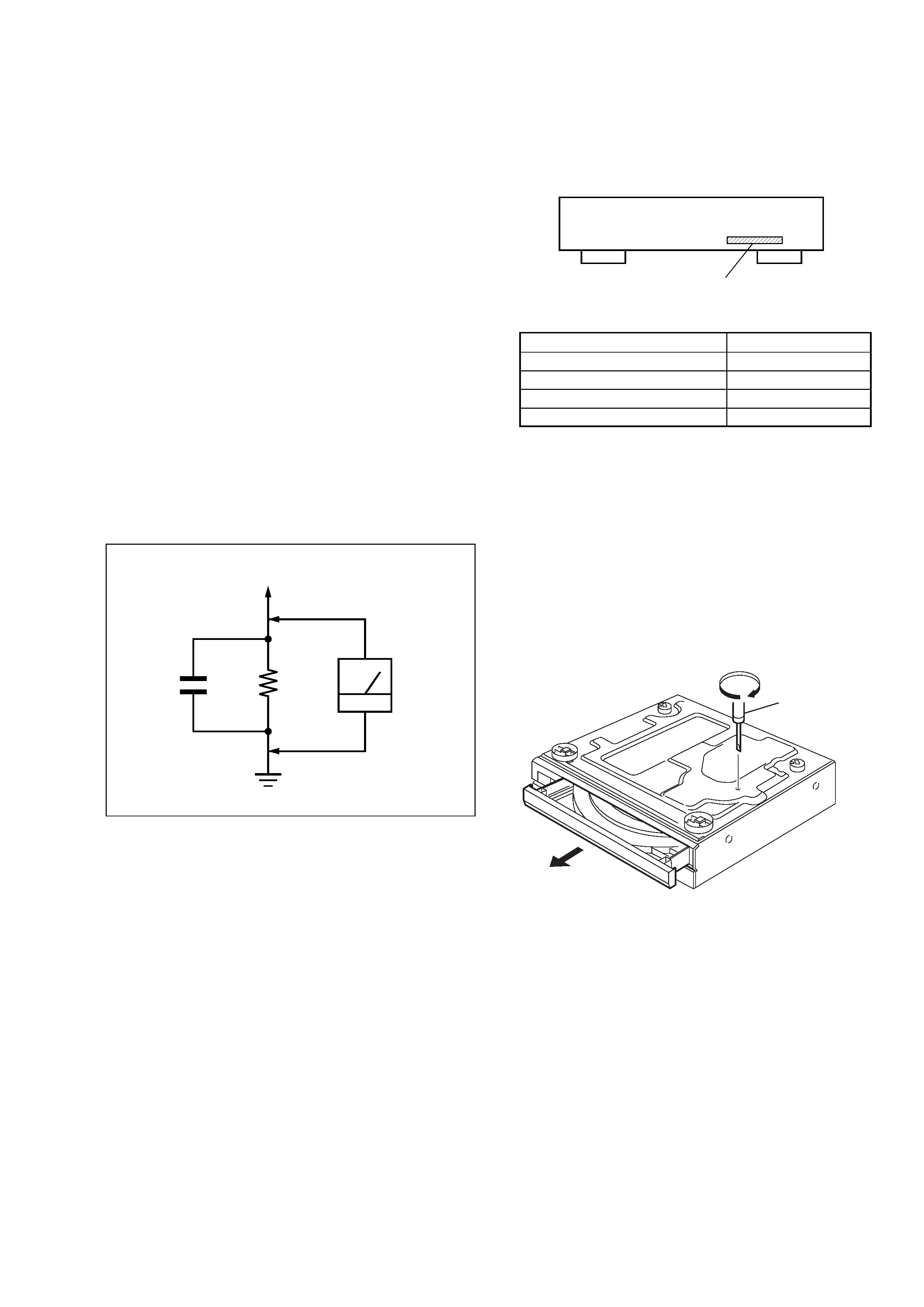
3
SCD-CE595
SECTION 1
SERVICING NOTES
HOW TO OPEN THE DISC TRAY WHEN POWER
SWITCH TURNS OFF
Insert a tapering driver into the aperture of the unit bottom, and turn
in the direction of arrow.
Use a flat (-) head screwdriver to open the disc tray by manual
operation. (Flat head screwdriver with nominal blade length of
3mm.)
* To close the disc table, turn the driver in the reverse direction.
tapering driver
1
2
Parts No.
MODEL IDENTIFICATION
Back Panel
MODEL
Part No.
US Model
4-255-250-0[ ]
Canadian Model
4-255-250-1[ ]
AEP Model
4-255-250-2[ ]
UK Model
4-255-250-3[ ]
SAFETY CHECK-OUT
After correcting the original service problem, perform the following
safety check before releasing the set to the customer:
Check the antenna terminals, metal trim, "metallized" knobs, screws,
and all other exposed metal parts for AC leakage.
Check leakage as described below.
LEAKAGE TEST
The AC leakage from any exposed metal part to earth ground and
from all exposed metal parts to any exposed metal part having a
return to chassis, must not exceed 0.5 mA (500 microamperes.).
Leakage current can be measured by any one of three methods.
1. A commercial leakage tester, such as the Simpson 229 or RCA
WT-540A. Follow the manufacturers' instructions to use these
instruments.
2. A battery-operated AC milliammeter. The Data Precision 245
digital multimeter is suitable for this job.
3. Measuring the voltage drop across a resistor by means of a
VOM or battery-operated AC voltmeter. The "limit" indication
is 0.75 V, so analog meters must have an accurate low-voltage
scale. The Simpson 250 and Sanwa SH-63Trd are examples
of a passive VOM that is suitable. Nearly all battery operated
digital multimeters that have a 2 V AC range are suitable. (See
Fig. A)
Fig. A.
Using an AC voltmeter to check AC leakage.
1.5 k
0.15
µF
AC
voltmeter
(0.75 V)
To Exposed Metal
Parts on Set
Earth Ground
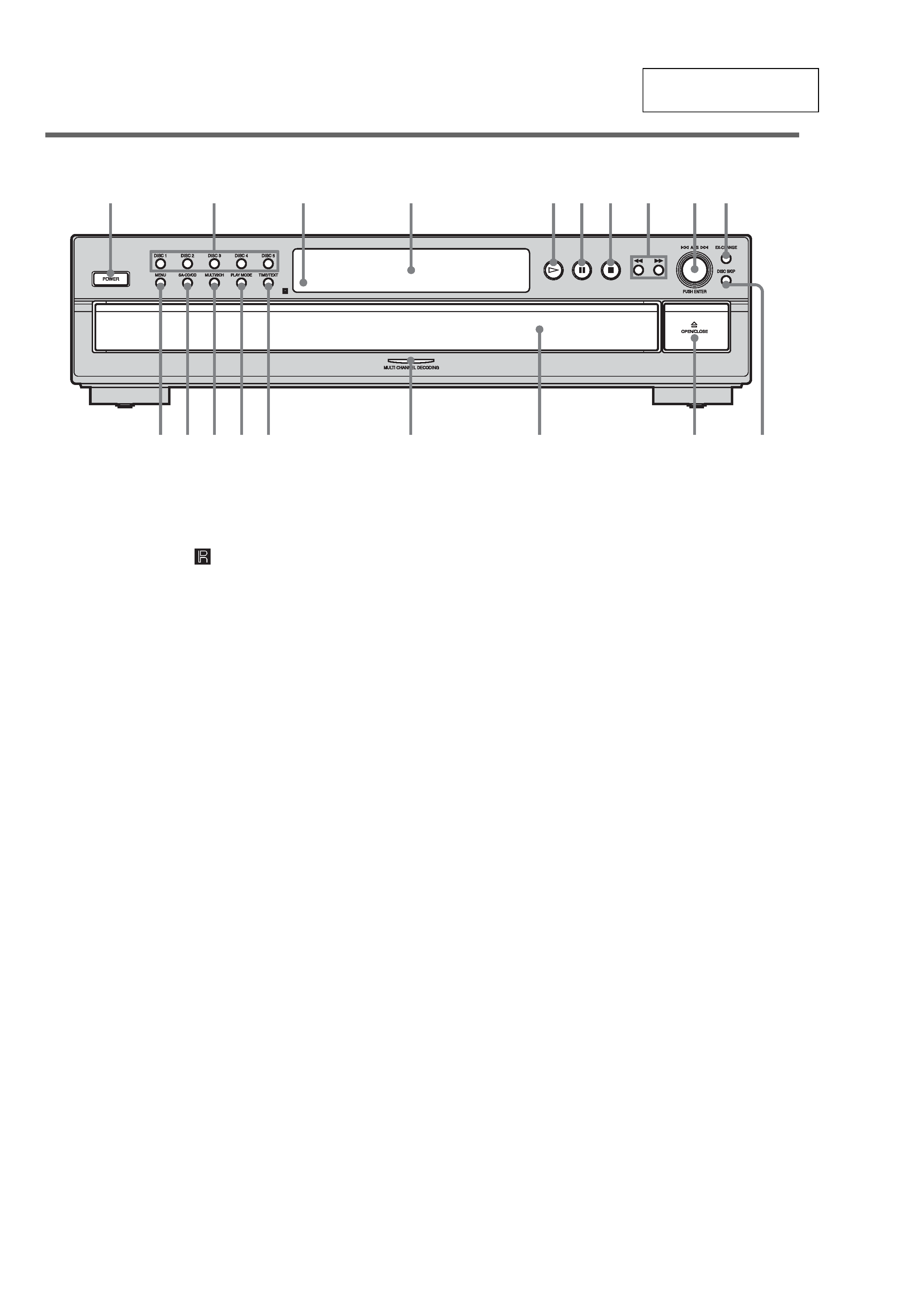
4
SCD-CE595
SECTION 2
GENERAL
This section is extracted
from instruction manual.
Front Panel
A POWER switch (9)
B DISC 1-5 buttons (9, 14)
Press to select the disc directly.
C Remote sensor
(6)
D Display window (10)
E H button (9, 13, 14)
F X button (9)
G x button (9, 15)
H m/M buttons (13)
I l AMS L dial
(AMS: Automatic Music Sensor) (8, 9, 10,
12, 13, 14, 16, 17, 19)
J EX-CHANGE button (12)
Press to replace discs while playing a disc.
K DISC SKIP button (9, 12, 14)
Press to select the disc.
L A OPEN/CLOSE button (9)
M Disc tray (9)
N MULTI CHANNEL DECODING indicator
Turns on when you turn on the player, or when the
Multi-channel Super Audio CD is loaded and
select the multi-channel playback area by pressing
MULTI/2CH.
O TIME/TEXT button (11)
Each time you press the button, the playing time of
the track, the remaining time of the disc, or TEXT
information appears in the display.
P PLAY MODE button (9, 14)
Press to select the play mode.
Q MULTI/2CH button (5, 10)
Press to select the playback area when a disc with
the 2 channel area and the multi-channel area
(page 5) is loaded.
R SA-CD/CD button (5, 9)
Each time you press the button while playing back
a hybrid disc, the layer to be played back switches
between the SA-CD layer and the CD layer.
S MENU button (8, 9, 10, 12, 16, 17, 19)
Press to enter the menu.
Press to exit from the menu and return to the
normal display.
12
3
4
5 6 7
8
9 q;
qa
qs
qd
qf
qg
qh
qj
qk
ql
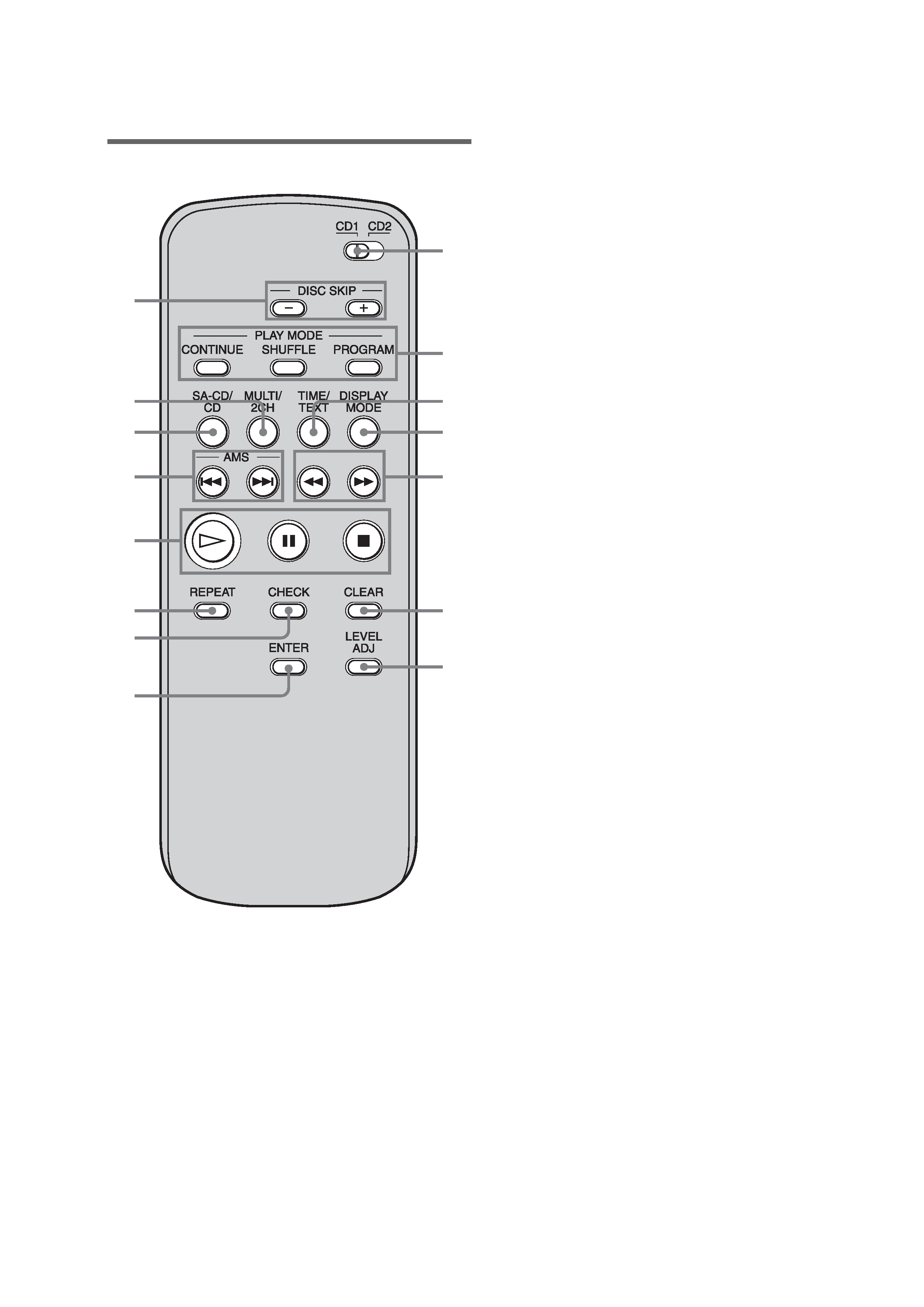
5
SCD-CE595
Remote
A CD1/2 (command mode) switch (8)
Select the command mode.
B CONTINUE button (9, 14)
Press to resume Continuous Play from Shuffle Play
or Program Play.
SHUFFLE button (14)
PROGRAM button (14)
C TIME/TEXT button (11)
Each time you press the button, the playing time of
the track, the remaining time of the disc, or TEXT
information appears in the display.
D DISPLAY MODE button (12)
Press to turn the display information off or on.
E m/M buttons (13)
F CLEAR button (14, 15)
Press to delete a programed track number.
G LEVEL ADJ button (17)
Press to adjust the output level balance for the
Multi-channel management function (page 15).
H ENTER button (8, 10, 12, 14, 16, 18, 19)
I CHECK button (15)
Press to check the programed order.
J REPEAT button (13)
K H button (9, 13, 14)
X button (9)
x button (9, 15)
L AMS ./> buttons
(AMS: Automatic Music Sensor) (8, 9, 10,
12, 13, 14, 16, 18, 19)
M SA-CD/CD button (5, 9)
Each time you press the button while playing back
a hybrid disc, the layer to be played back switches
between the SA-CD layer and the CD layer.
N MULTI/2CH button (5, 10)
Press to select the playback area when a disc with
the 2 channel area and the multi-channel area
(page 5) is loaded.
O DISC SKIP +/ buttons (9, 12, 14)
Press to select the disc.
qg
qf
qd
qs
qa
q;
9
8
1
2
3
4
5
6
7
